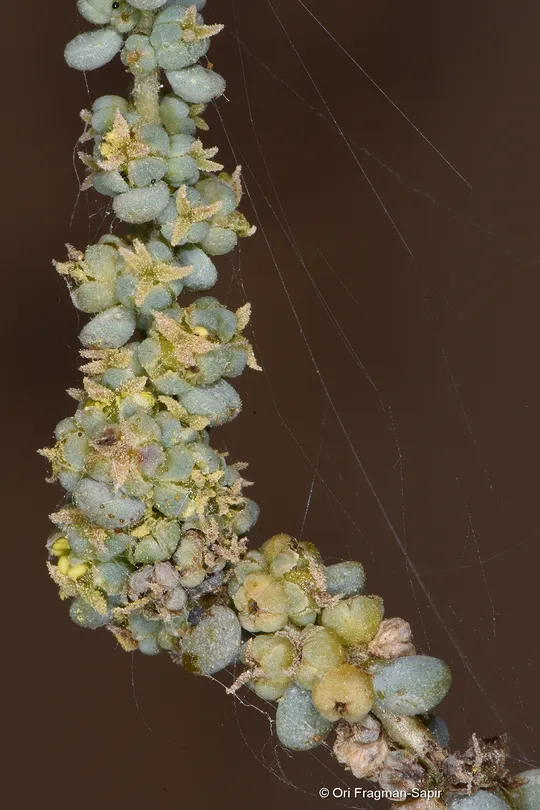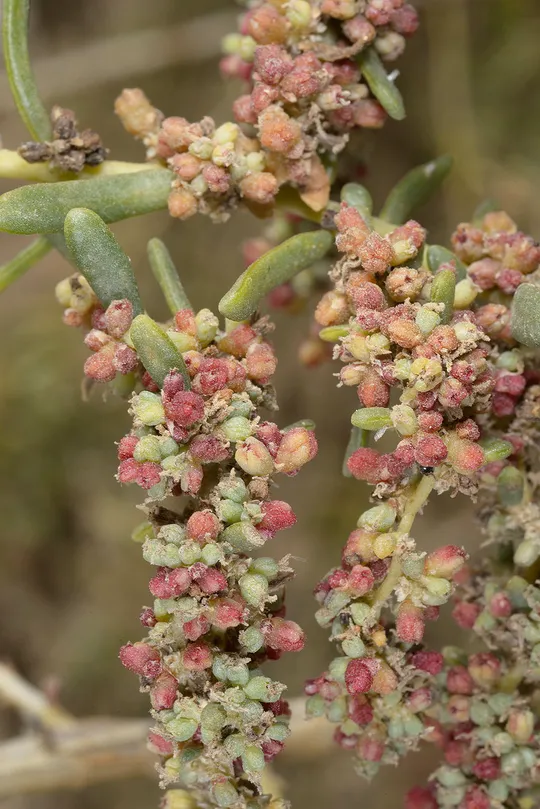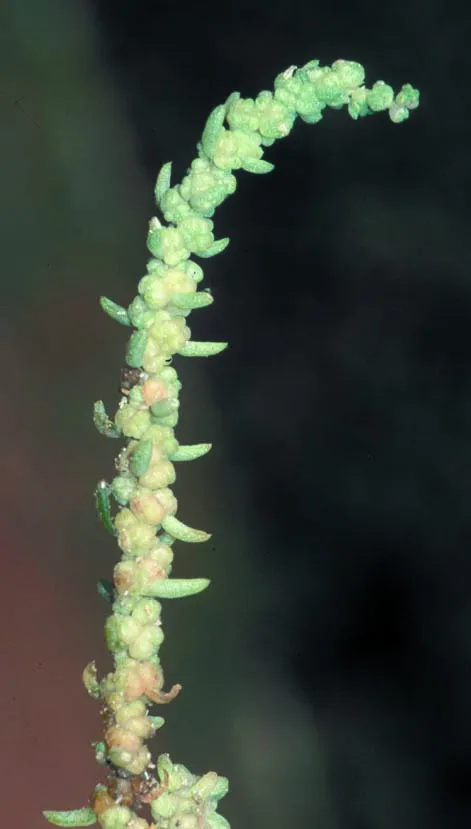Halocnemum strobilaceum
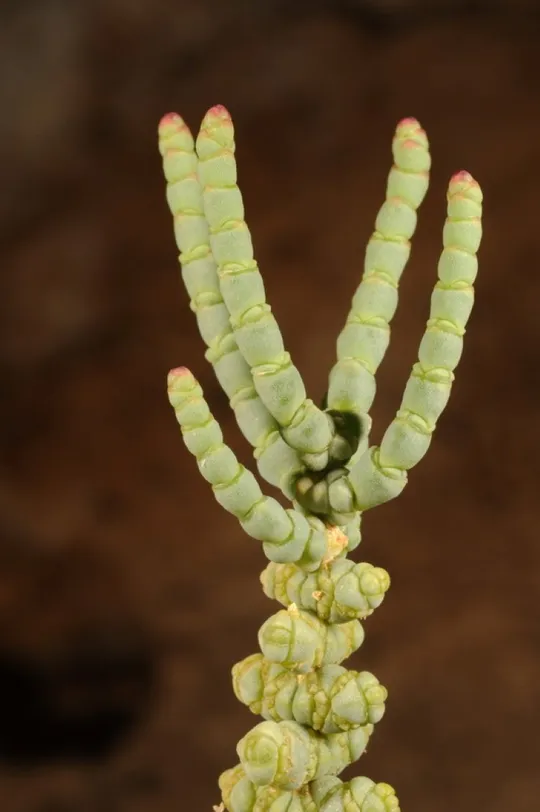
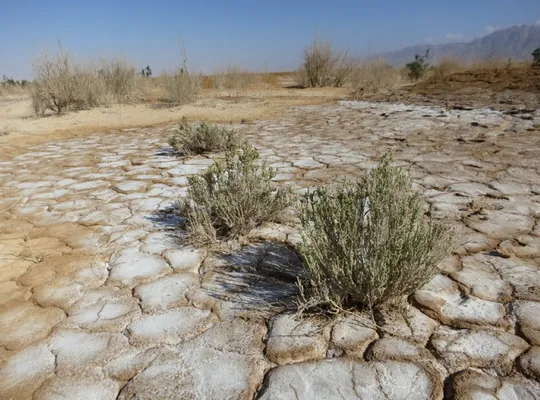
Halocnemum
strobilaceum is used
for grazing sheep and camels, as it remains green even in the driest seasons.
Bedouins in northwestern Arabia believe that overeating H. strobilaceum
stalks causes lung disease in camels.
Halocnemum strobilaceum is apparently
extinct in Israel. In the Flora Palaestina and in Wiesel and Agami (1979) it is noted from the Dead Sea coast and
northern Negev in the past, but there is no evidence of this in the Herbarium.
In the Flora Palaestina it is noted from the "coastal Negev"
(probably the El-Arish coast) and the Dead Sea based on Post's Flora (Post,
1932) but Zohary stresses in the Flora that
it was not observed by the Flora authors. Post notes that there is a herbarium
data sheet from the Safi salt marshes south of the Dead Sea. Efforts to
discover the plant on the Dead Sea coastal salt marshes and Ne'ot HaKikar were
fruitless. The accepted theory was that it grew in the eastern part of the Dead
Sea outside the borders of Israel, but it has not been found there in searches
made since 1995 in the Safi and Mazra'a
salt marshes. The plant is common in the northern Sinai salt marshes and also grows
in Southern Sinai.
Halocnemum strobilaceum inhabits mainly
humid coastal salt marshes but it sometimes penetrates inland in salt marshes.
It grows in lagoons and coastal marshes, at particularly high salt
concentrations, in sodium-rich and sometimes sulfur-rich unaerated soil. In
northern Sinai salt marshes, it usually creates a zone at the edge of the
sterile center of the salt marsh (Wiesel and Agami, 1979).
In northern Sinai, it dominates in the Bardawill lagoon
and in the coastal salt marshes together with Arthrocnemum macrostachyum.
In Egypt, Southern Sinai and on the Gulf of Suez coast H. strobilaceum grows on
saline sand dunes up to two meters high bordering the sea, and around the
lagoons that are a bit farther from the sea.
Halocnemum is a monotypic genus consisting of a single species, in
the Chenopodiaceae family that belongs to a group with jointed stems growing
in salt marshes. The species distribution overlaps the area covered by the ancient
Tethys Ocean. Some believe that the distribution of H. strobilaceum in the Caspian
Sea salt, Aral Sea and the Central Asian salt marshes indicate the
drying of the Tethys Ocean at the end of the Pliocene and the formation
of giant salt marshes.
In the family Chenopodiaceae
there are two convergent groups (i.e. plants that have different origins but
are similar morphologically and ecophysiologically) that lack leaves and have
instead green stems with short internodes separated by distinct horizontal
nodes: the Anabasis and Haloxylon group and the Arthrocnemum
and Sarcocornia group. They differ in the structure of their
inflorescence and flowers: the Anabasis group has winged fruits and it
populates extreme deserts, whereas the Arthrocnemum group does not have
winged fruit and it grows in humid salt marshes, marshes and lagoons. H.
strobilaceum belongs to
Arthrocnemum group.
Halocnemum strobilaceum is extinct from
Israel (if indeed it ever grew heret). Due to the uncertainty of its location, it
is not possible to assess the reasons for its local extinction. The species is
not globally endangered.
Halocnemum strobilaceum should be reintroduced
to Israel to the southern Dead Sea salt marshes, in view of the fact that it
once grew in this region, in the Safi salt marsh in Jordan. Acclimatization in
a Mediterranean coastal salt marsh, such as the Taninim Stream, should also be
considered, as it is found on the Northern Sinai beaches and in the coastal
salt marshes in Cyprus.
Halocnemum strobilaceum has a very broad
distribution from the North African salt marshes through the Mediterranean Basin
and up to Central Asia; this is a Mediterranean Irano-Turanian plant that penetrates
both to the southern Euro-Siberian and Sudanian regions. In hot, arid areas, the
species prefers coastal sites and does not actually penetrate to the Saharan
and Arabian desert salt marshes. H. strobilaceum grows on the coast of the Gulf of
Suez, the Red Sea and is common in the Persian Gulf. In Asia, it penetrates
inland up to Uzbekistan. In the eastern Mediterranean, it grows on coastal salt
marshes in Cyprus, Turkey, and in the Syrian Desert salt marshes connected to
the Euphrates River. It is very rare on the coast of the Gulf of Elat. In North
Africa it is found in undrained depressions bordering the Sahara Desert
Halocnemum
strobilaceum is
a small perennial fleshy dwarf shrub that grows in the Mediterranean and
Central Asian coastal salt marshes, which is probably extinct from Israel.
However, the evidence about its presence in the past at a few sites within in
Israel is not unequivocal.
ויזל, י. ואגמי,מ. 1979. צמחי מלחה בישראל. הוצאת המדור לאקולוגיה, פתח תקווה.
Current Occupancy Map
| 1000 squre meter pixel | 5000 squre meter pixel | 10000 squre meter pixel | |
|---|---|---|---|
| number of observations | 0 | 0 | 0 |
| in total pixels | 0 | 0 | 0 |
| Family | Chenopodiaceae |
| Classification | On the endangered species list |
| Ecosystem | Desert |
| Chorotype | Mediterranean – Irano-Turanian – Saharo-Arab (Euro-Siberian) |
| Conservation Site |
| Rarity |
1
6
6
|
|---|---|
| Vulnerability |
0
4
4
|
| Attractiveness |
0
0
4
|
| Endemism |
0
0
4
|
| Red number |
1
5.2
10
|
| Peripherality | 0 |
| IUCN category | DD EW EX LC CR EN VU NT |
| Threat Definition according to the red book | Endangered |
 Based on:
Based on:
